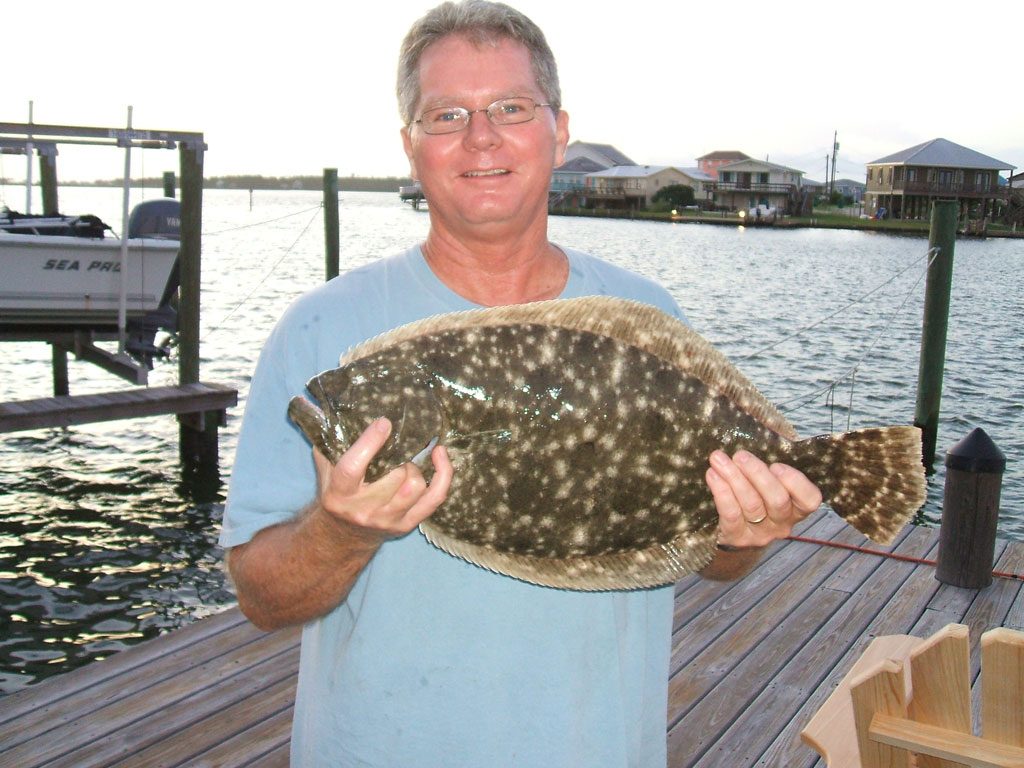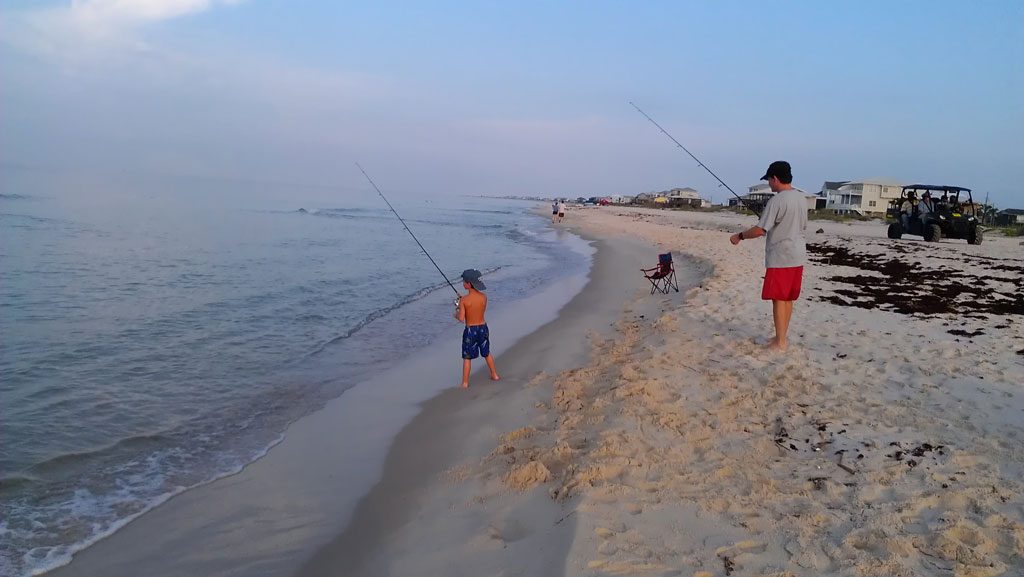Try to Beat the Heat for Better Fishing
August marks the peak of summer heat and humidity along the Emerald Coast. Anglers can expect water temperatures to languish in the middle 80s while air temperatures often reach the middle to upper 90s during the day. At least these temperatures are often, though only temporarily, suppressed by frequent thunderstorms or showers.
Clouds may offer a respite from the searing heat, but add to the woes of dealing with unrelenting humidity more related to tropical regions. After all, it is the middle of hurricane season and the central Gulf Coast region has been historically aware of the bedlam that can bring. Let’s hope for another year we are spared the worst of what may brew up from the tropics!
Game fish for the most part respond to such tepid conditions by avoiding shallow waters during the heat and bright midday sunlight, preferring to feed in low light conditions or even at night especially during the full moon period around Aug. 7.
Some pelagic fish like king mackerel may even move several miles offshore where they can find water temperatures a bit more in their comfort zone. The primary exceptions are the vast schools of young-of-the-year baitfish that use the warm and fertile shallow waters to fuel their growth on the abundant plankton. The other exceptions are the varied species that can tolerate the heat better and use this vast food supply to fuel their own growth. Most of the jack species such as ladyfish, blue runner, leatherjacks, Atlantic bumper, etc. feed heavily on these young baitfish. They often pursue them all the way to the shoreline where they become easy targets for even shore-bound anglers.

Find the Bait
Farther west, along the Alabama beaches and in the nearshore back bays, these subtropical pelagic species are joined by the inshore species of speckled trout, silver and sand seatrout (called “white trout”), redfish and flounder to feast on the abundant small prey. These fish are often concentrated anywhere the baitfish accumulate or frequent such places as piers, docks, jetties, passes and bridges especially if those structures offer night lighting. Savvy anglers have learned to beat the sultry summer heat by night fishing around lighted piers bridges and docks under these conditions.
Live shrimp or small baitfish presented on light tackle are primarily used by these anglers, but the fish often respond just as well to a variety of small artificial lures that ‘match the hatch’ so to speak. Shrimp imitations like D.O.A. or Gulp! especially in the 3-inch size are great when free-lined under the lights or placed on a ¼-ounce leadhead jig and bounced off the bottom.
Just as good and sometimes better, the 3-inch soft-plastic minnow imitations like Fin-S or Tiny Fluke resemble the minnows that teem around the lights. These can be fished with just a long shanked Number 4 single hook or a 1/16-ounce crappie jighead for a very lifelike presentation. Bring plenty of tails though because the fish literally eat them up! For added enjoyment and challenge, try fishing these lures on 4-pound ultralight spinning tackle. Even the common 10-inch white trout will test your tackle under these conditions.
On the Piers
Fishing from the Gulf Coast piers from Panama City Beach, Fla. to Gulf Shores, Ala. is still primarily for mackerel, especially Spanish mackerel, but the variety of species available goes far beyond those. Bluefish, guaguanche barracuda, mangrove snapper and numerous exotic and juvenile jack species are in abundance and easy to target at times. Anglers using ordinary bass fishing setups like a 7-foot medium-action rod and a 2000- or 3000-series spinning reel with 6- or 8-pound-test line can catch these fish.
Though most are good to fair eating, they certainly can provide hours of entertainment for young and more experienced anglers alike simply by catch and release. The intermediate-sized game fish will not only eat the variety of native baitfish available around the pier, but often respond well to artificial lures that mimic small bait. Some good lure examples include such medium-sized plugs as Rapala X-Raps, Yo-Zuri Crystal Minnows and Bomber Long-As in addition to silvery 1/2- to 1-ounce silver spoons such as a Tony Acetta Mr. Champ, Acme Kastmaster and Sidewinder or Luhr-Jenson Crippled Herring.
These lures are best fished on medium to medium-heavy spinning tackle in the 10- to 15-pound class with 3000- to 4000-series sized reels loaded with 200 yards of 8- to 12-pound-test line. A heavy monofilament, fluorocarbon or light wire leader is usually necessary to prevent being cut off by ladyfish, blues or mackerel.
Not that the big game species, like king mackerel, cobia, jack crevalle, bull reds and even tarpon, are unavailable, but rather they are often much less frequently encountered during August. Besides casting and toting a medium-heavy or heavy spinning rig for hours under stressful midsummer conditions can wear an angler out quickly. However when calm conditions prevail and offshore currents are favorable, the water may get quite clear and salty. This condition could bring within reach of the Panhandle pier anglers more exotic offshore tropical species such as dolphin fish (mahi), sailfish and blackfin tuna. These are prized fish that offer once-in-a-lifetime experiences for many pier anglers.

Shore and Wade Fishing
Good shore and wade fishing opportunities abound, primarily at first light or near dusk when fish are more apt to feed most heavily. Pompano are still available in the surf zone, as are whiting, which usually feed near shore around high tide, but they often spread out. Whiting are more efficiently fished using light or ultralight spinning tackle while throwing 1/4- to 3/8-ounce leadhead jigs or a ‘Goofy jig’ setup tipped with a small piece of shrimp and dragged along the bottom. This method may even produce an occasional flounder or the ever-present ladyfish. In fact, much of the action along the Gulf Coast beaches is limited to ladyfish or the other abundant jack species or bluefish, but Spanish mackerel may occasionally come within casting range for waders and jetty anglers, especially those throwing 3/4-ounce silver spoons.
Again, farther west in Alabama waters, speckled trout are a popular target species for wading anglers throwing a variety of hard twitch baits like MirrOlure 52M sinking series, Unfair Lures’ Rip N Slash 90 or Yo-Zuri Pin’s Minnow. Soft plastic lures work great too. Try a Fin-S and Zoom Fluke in the 4-inch size on a 1/4-ounce leadhead jig. Topwater lures such as Heddon Zara Spook Jr, Rapala Skitter Walk or MirrOlure Top Dog Jr. work well at times of low light or calm water, producing massive strikes that can heat up an angler’s day faster than the searing sun!
Let’s pray we experience no direct influences from tropical activity this month, so we can continue to enjoy these great fishing opportunities and our great days outdoors!



